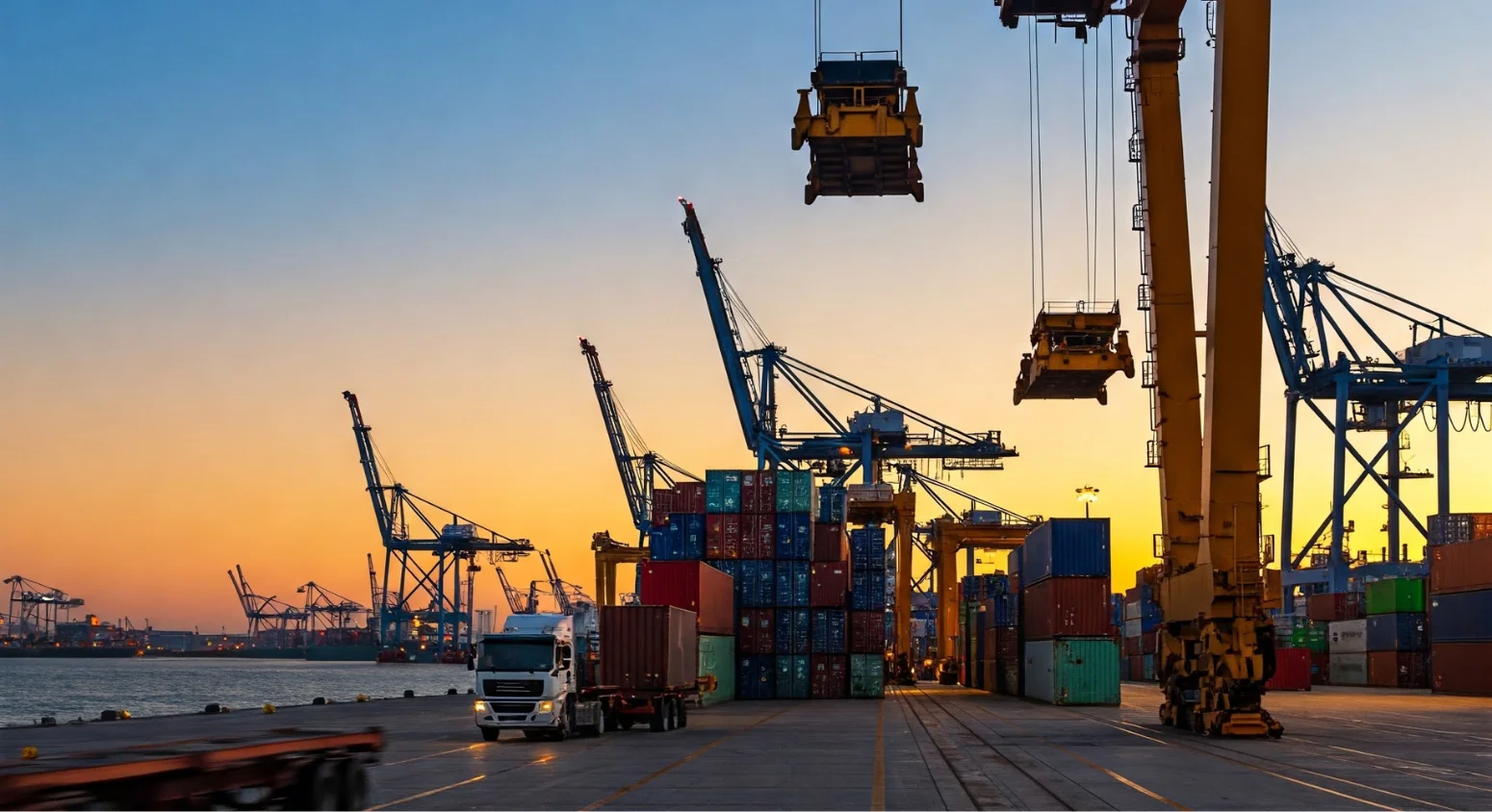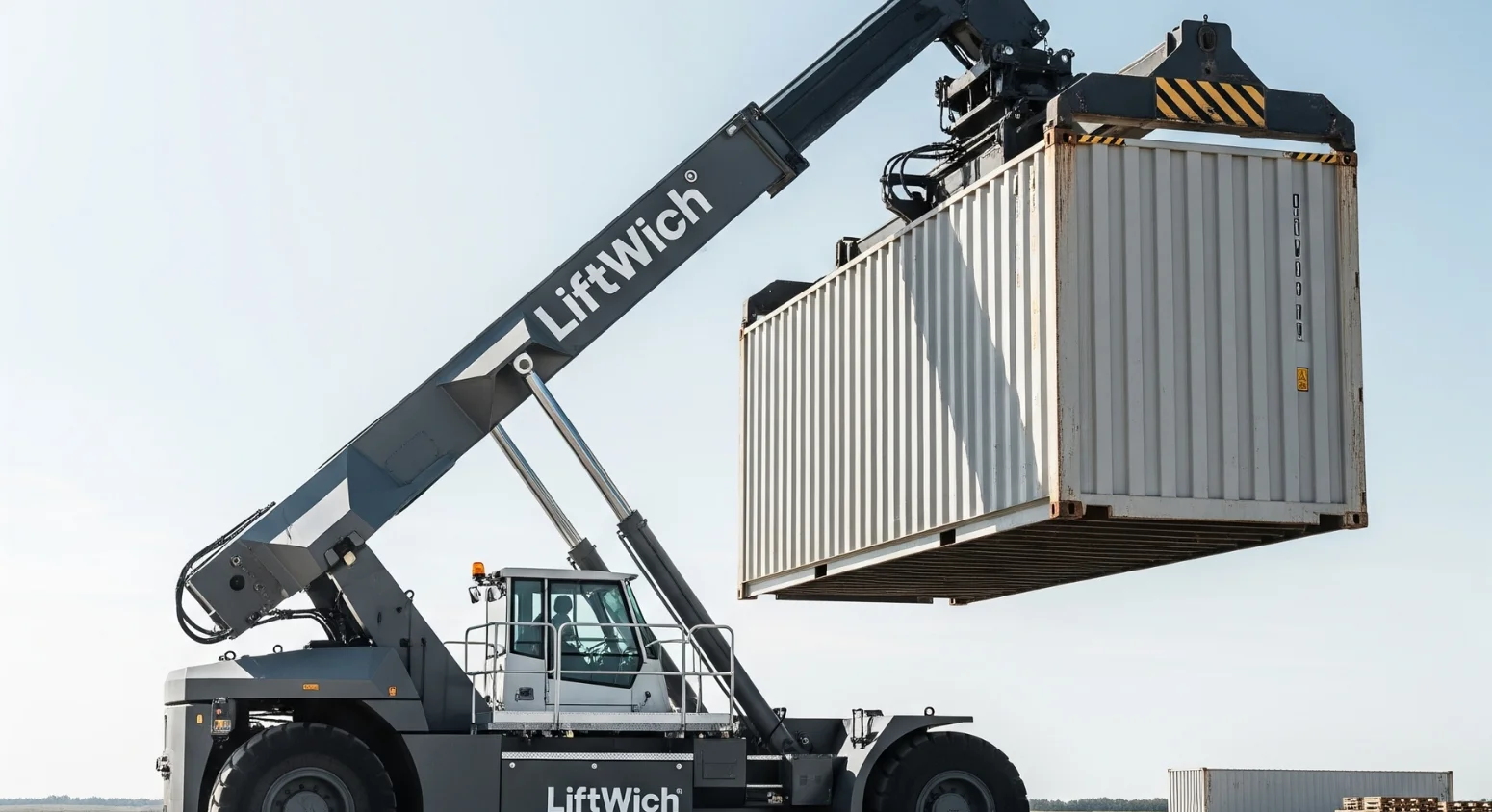Moving containers from one place to another might seem straightforward—but when you’re running a busy port, managing a packed warehouse, or coordinating a large logistics center, it quickly becomes a big challenge. Each of these places has its own layout, pace, and demands. What works well at a port might not work inside a warehouse, and logistics centers come with their own unique problems to solve.
So, how do you find the right way to move containers in each of these environments? And how do you keep things running smoothly without wasting time, space, or energy?
In this blog, we’ll look at practical container transport solutions designed for real-world use in ports, warehouses, and logistics centers. You’ll learn how the right equipment and setup can make your operations faster, safer, and more cost-effective—no matter where you’re working.
Table of Contents
1. Adapting Container Transport to Different Environments
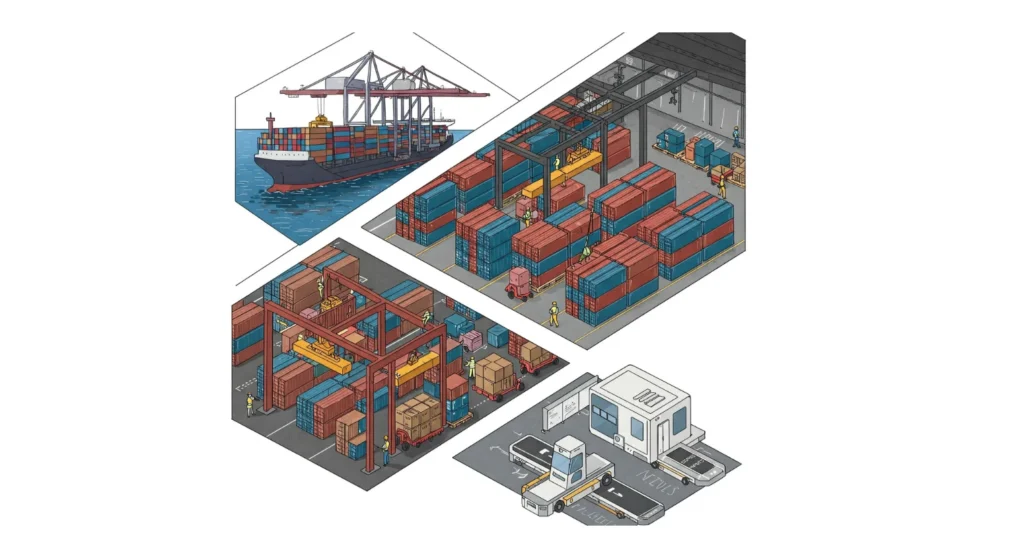
Not all container transport operations are created equal—and that’s exactly why a smart, flexible approach is key. Think about it: a bustling port, a compact warehouse, and a fast-moving logistics center all handle containers, but each does so in very different ways. So, why rely on a single solution?
Understanding the unique needs of each space helps you choose equipment and systems that boost efficiency without adding unnecessary complexity.
What Makes Each Environment Different?
Let’s break it down:
- Ports deal with heavy volumes, unpredictable weather, and outdoor surfaces. They require rugged, high-capacity equipment that can keep up with the pace of port services.
- Warehouses often operate within tighter indoor spaces where maneuverability and space-saving tools are essential. Here, the focus is on precision and protecting both containers and floors—making warehouse services more detail-oriented.
- Logistics centers are all about speed and synchronization. Containers come and go quickly, so flexible, easy-to-deploy solutions are a must. That’s where efficient logistics services really shine.
Why a One-Size-Fits-All Approach Fails
Using the same tools in every environment leads to wasted time, equipment strain, and even safety risks. Instead, ask yourself:
- Is the terrain smooth or uneven?
- How tight is the space for turning or lifting?
- What’s the average container size and weight?
- How often are containers moved in and out?
The answers to these questions should guide your container transport strategy.
Choosing Tools That Work Where You Work
Here’s what adaptable solutions should look like:
- Modular equipment that works across multiple surfaces.
- Low-clearance tools that easily move containers in tight areas.
- Weather-resistant gear built to withstand port conditions.
- Quick-connect systems that reduce downtime between moves.
By matching the right solution to each environment, you’ll streamline workflow, reduce wear and tear on equipment, and keep your team safer.
Tailoring your container transport approach to fit the specific needs of ports, warehouses, and logistics centers isn’t just smart—it’s essential. The more you understand your environment, the better your results.
2. Equipment Solutions That Boost Efficiency
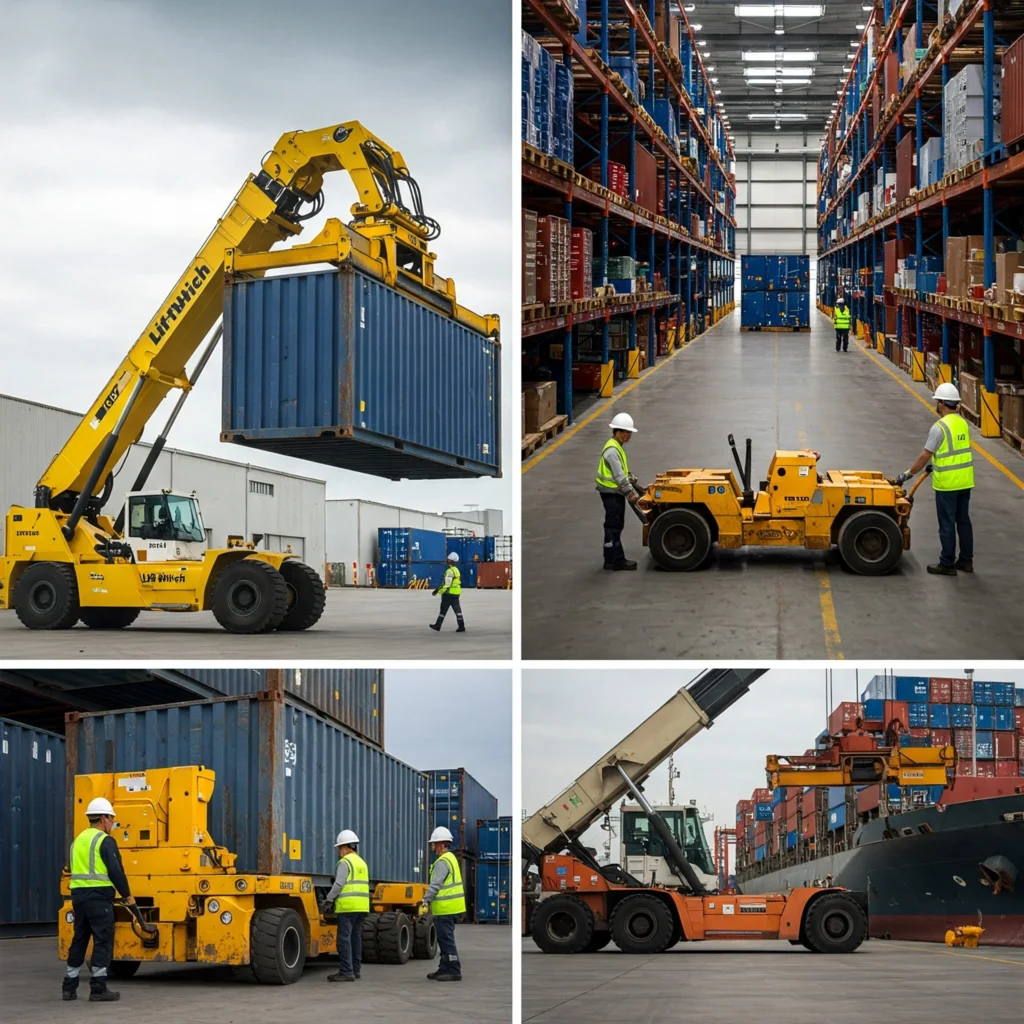
If you’re in the business of moving containers, you already know—having the right equipment isn’t a luxury. It’s a necessity. Whether you’re operating in a tight warehouse, a busy port, or a fast-paced logistics center, the right tools can mean the difference between smooth operations and costly delays.
But what exactly qualifies as the “right” equipment? It depends on where you’re working, what you’re moving, and how often you’re doing it.
Matching Equipment to the Job
Let’s take a closer look at some of the most effective container handling tools and when to use them:
- Shipping Container Dollies
These are perfect for rolling containers across flat surfaces with minimal resistance. Ideal for warehouse use, shipping container dollies make moving containers faster, easier, and safer—especially in environments where floor protection matters. - Vehicle Wheel Dollies for Tight Warehouse Corners
In tight indoor settings, wheel dollies or automotive wheel dollies are game-changers. Their smooth, multidirectional movement allows you to maneuver containers with precision, even in narrow aisles or packed storage areas. - LiftWich: Your Go-To Container Jack
For heavy lifting without the need for forklifts or cranes, the LiftWich from TriWich is a standout. Acting as a compact, high-powered container jack, the LiftWich allows one person to lift fully loaded shipping containers safely and efficiently.
This tool is ideal for environments where flexibility and mobility matter. Whether you’re operating in a port, warehouse, or logistics hub, LiftWich bridges the gap between power and convenience—making it one of the most versatile container lifting jacks on the market. - Heavy Duty Wheel Dolly for Outdoor Terrain
For operations involving rough terrain, such as construction sites or open yard logistics, a heavy duty wheel dolly or heavy duty casters provide the durability and shock absorption needed to keep things moving—no matter the conditions. - Tire Dolly Wheels and Auto Dolly Wheels
These are especially useful for automotive and trailer container handling where modular movement and quick alignment are key. Both tire dolly wheels and auto dolly wheels support agile repositioning without straining the structure of the load or the floor underneath.
Efficiency Starts with the Right Tools
Choosing the best-fit equipment isn’t just about lifting capacity—it’s about how easily the tool integrates into your workflow. Here’s what to look for:
- Load Compatibility – Will it handle your container’s size and weight?
- Surface Adaptability – Can it move across your floor or terrain without damage?
- Ease of Use – Is it easy to operate, even with limited manpower?
- Safety Features – Does it offer stability during lifting and moving?
Real-World Impact
Companies that switch to more efficient tools like LiftWich or precision wheel dollies often report:
- Shorter container turnaround times
- Fewer workplace injuries from manual handling
- Reduced wear on floors and loading surfaces
- Long-term savings on equipment maintenance and labor costs
With solutions like container lifting jacks, vehicle wheel dollies, and shipping container dollies, you’re not just moving containers—you’re moving your entire operation forward. The right tools help you work faster, safer, and smarter.
So, are your current tools doing the job? Or is it time for an upgrade?
3. Improving Safety, Speed, and Sustainability
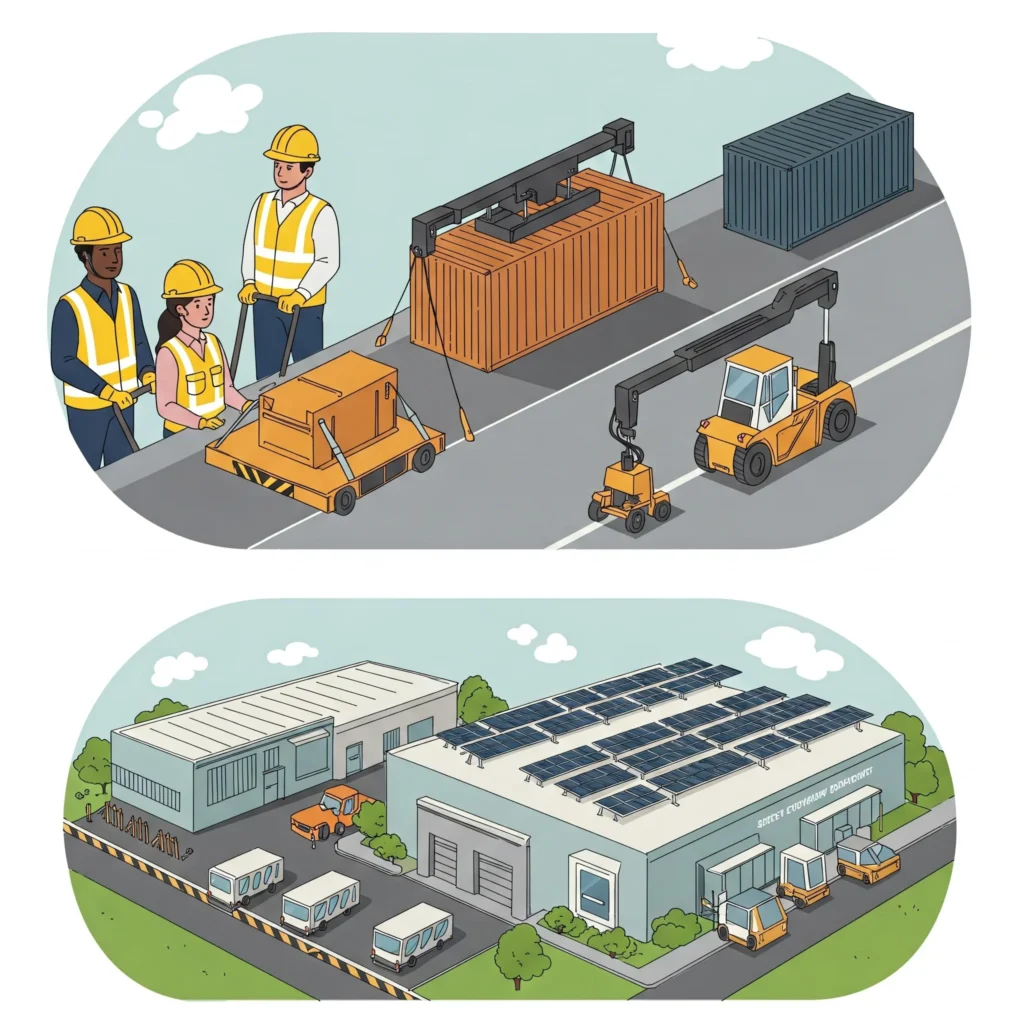
When it comes to moving containers, it’s not just about getting the job done—it’s about doing it safely, quickly, and in a way that’s good for the planet. If you’re running a busy port, warehouse, or logistics center, you know how important it is to keep things moving smoothly without putting people or equipment at risk. But how can you achieve all this without sacrificing speed or efficiency?
Let’s take a closer look at how the right equipment and strategies can help you balance safety, speed, and sustainability.
Keeping It Safe for Everyone
Safety is a top priority. After all, you’re working with heavy equipment and valuable cargo, so you want to avoid accidents that can hurt your team or damage products. Here’s how to keep things safe:
- Shock-Absorbing Technology
Whether you’re moving containers in a busy port or a tight warehouse, using tools with shock-absorbing features can prevent damage to both your equipment and the containers themselves. This makes lifting smoother and reduces risks of accidents, ultimately protecting your investment. - Ergonomic Equipment
When workers are moving containers by hand, ergonomic designs can reduce strain and prevent injuries. Tools that are comfortable to use help keep your team safe and productive, especially in logistics services, where workers might be on the move for long periods. - Built-in Safety Features
Many modern systems now come with automated safety features like emergency stop buttons and warning alarms. These simple additions make a huge difference, ensuring everyone stays safe while the operation runs efficiently.
Speed Up Without Losing Control
We all know that speed matters—whether you’re in a busy port or moving things inside a warehouse, getting containers in and out quickly is crucial. But how can you speed things up without mistakes?
- Faster Loading and Unloading
In ports, where containers are constantly being moved, using equipment designed for quick loading and unloading can save a lot of time. Tools like shipping container moving services allow you to move containers faster, meaning you can handle more shipments in less time. - Quick Setup Tools
In logistics centers, where flexibility and speed are key, modular systems that are easy to set up and change configurations allow your team to stay fast without getting slowed down. This keeps the operation moving quickly without wasting time.
Sustainability: Good for Business and the Planet
More and more, people are focusing on ways to make their operations greener. Moving containers doesn’t have to be bad for the environment. In fact, there are many ways to make your equipment and processes more sustainable:
- Energy-Efficient Equipment
Choosing energy-efficient machines, like electric-powered lifts or low-emission vehicles, can reduce your carbon footprint and lower fuel costs in the long run. - Eco-Friendly Materials
Using equipment made from durable, sustainable materials means it lasts longer and needs fewer replacements, which is better for the environment. - Longer-Lasting Equipment
High-quality equipment that lasts longer reduces waste. It also cuts down on the need to buy new tools as often, saving money and reducing the resources you consume.
The Bigger Picture: Investing in Smarter Solutions
By focusing on safety, speed, and sustainability, you not only improve the day-to-day efficiency of your operation but also build a more responsible and cost-effective business in the long run. It’s all about working smarter and safer, so you can move more containers, make fewer mistakes, and help the planet while you’re at it.
So, it’s clear: when it comes to container transport, it’s not just about getting things done quickly. With the right focus on safety and sustainability, you can improve every aspect of your operation while making a positive impact on your bottom line and the environment. Ready to take the next step in optimizing your container transport process?
4. Choosing the Right Solution for Your Operation
So, you’ve got a lot of options when it comes to container transport, but how do you pick the right solution for your specific needs? The truth is, there’s no one-size-fits-all answer. Every environment—whether it’s a port, a warehouse, or a logistics center—has unique challenges that require different tools and strategies.
How do you make sure you’re investing in the right equipment for your operation? Let’s dive into the factors you should consider when choosing the best container transport solutions.
Step 1: Assess Your Environment
Before you decide on the right equipment, take a moment to really assess your environment. What are the specific needs of your site? Think about the following:
- Terrain and Layout: Is the area outdoors (like a port) or indoors (like a warehouse)? The terrain and space you have will play a big role in the type of equipment that works best.
- Volume of Containers: Do you handle a few containers a day or thousands? The scale of your operation determines the kind of machinery you need.
- Space Constraints: How tight are the spaces where you need to operate? Smaller, more compact equipment might be necessary for confined areas like warehouses.
Step 2: Choose Equipment That Matches Your Needs
Now that you’ve assessed the environment, you can start choosing equipment that suits your specific demands. Consider these options:
- Heavy-Duty Movers for Ports
If you’re working in a port, you’ll need robust, high-capacity movers designed to handle heavy containers in challenging outdoor conditions. Look for tools that offer both strength and speed, as container transport services at ports are fast-paced and require durable equipment. - Compact Solutions for Warehouses
In a warehouse, space is limited. Here, you’ll need equipment that’s flexible, compact, and easy to maneuver. Warehouse services often rely on wheel dollies or modular systems that make moving containers through tight aisles and up ramps simple and efficient. - Adaptable Systems for Logistics Centers
Logistics centers require versatility and speed. Modular lifting systems and adjustable equipment that can quickly adapt to different needs are essential. These solutions help streamline container handling and ensure quick turnaround times for logistics services.
Step 3: Consider Cost vs. Value
While it’s tempting to look for the cheapest option, it’s important to remember that cost isn’t the only factor. Consider the long-term value of your investment. Here’s what to keep in mind:
- Durability: Invest in equipment that will last longer, saving you money on repairs and replacements.
- Efficiency: Fast and efficient tools will reduce downtime and help your team handle more containers in less time, boosting productivity.
- Maintenance: Some equipment may require more upkeep than others. Be sure to factor in long-term maintenance costs when making your decision.
Step 4: Integration with Existing Systems
Before making a purchase, think about how the new equipment will fit into your current workflow. Will it integrate easily with your existing systems, or will it create disruptions? The right solution should work seamlessly with your current setup, making the transition smooth and easy.
- Compatibility: Will your existing staff be able to use the new equipment with minimal training? Look for user-friendly designs.
- Flexibility: Can the equipment be adapted as your business grows or changes? A flexible solution that can scale with your operation is always a smart choice.
Step 5: Evaluate Long-Term Sustainability
Finally, don’t forget about the long-term environmental impact. Sustainable equipment isn’t just good for the planet—it can also be good for your bottom line. Look for energy-efficient solutions that reduce emissions and minimize your energy consumption. This aligns with the growing trend of eco-conscious business practices, which can enhance your company’s reputation.
- Eco-Friendly Options: Choose equipment made with sustainable materials or that has energy-saving features.
- Waste Reduction: High-quality equipment that lasts longer helps reduce waste, keeping your operation more environmentally responsible.
The Takeaway: A Tailored Approach
Choosing the right container transport solution isn’t about picking the cheapest or the flashiest option. It’s about selecting the equipment that best suits your environment, meets your needs, and delivers long-term value. By carefully considering factors like space, volume, cost, and sustainability, you’ll ensure that your operation runs smoothly, safely, and efficiently.
So, what’s your next step in choosing the right solution? Whether you’re upgrading your existing equipment or starting from scratch, a thoughtful, tailored approach will make all the difference in boosting your efficiency and getting the most out of your container transport system.
Conclusion: Making the Right Move in Container Transport
When it comes to moving containers, it’s not just about getting them from one place to another—it’s about making the process as smooth, safe, and efficient as possible. Whether you’re working at a busy port, inside a warehouse, or in a logistics center, having the right tools and strategies in place is key to success. By focusing on the right equipment, improving safety, speeding up your processes, and being mindful of sustainability, you can set your operation up for long-term success.
So, what’s your next move? Are you ready to invest in the right equipment for your business? No matter what your environment looks like, there’s a solution that fits your unique needs. Taking the time to assess your situation and choose wisely will help you create a system that not only meets today’s challenges but is built for the future.
Frequently Asked Questions (FAQs)
1. What should I consider when choosing equipment for container transport?
Think about the space you have, how many containers you’re moving, and the specific needs of your operation. Durability, speed, and ease of use are also important factors to keep in mind.
2. How can I make my container transport operations safer?
Invest in equipment with shock-absorbing features, ergonomic designs, and built-in safety tools like emergency stop buttons. These features help reduce risks and protect your workers and equipment.
3. Why is sustainability important in container transport?
Sustainability helps reduce costs in the long run and improves your company’s environmental impact. Using energy-efficient equipment and reducing waste can lead to savings and make your business greener.
4. Can I update my current container transport system?
Definitely! Many modern solutions can work with your existing setup, whether it’s upgrading to energy-efficient systems, adding new technology, or switching to more compact equipment. You can improve your operations without starting from scratch.
